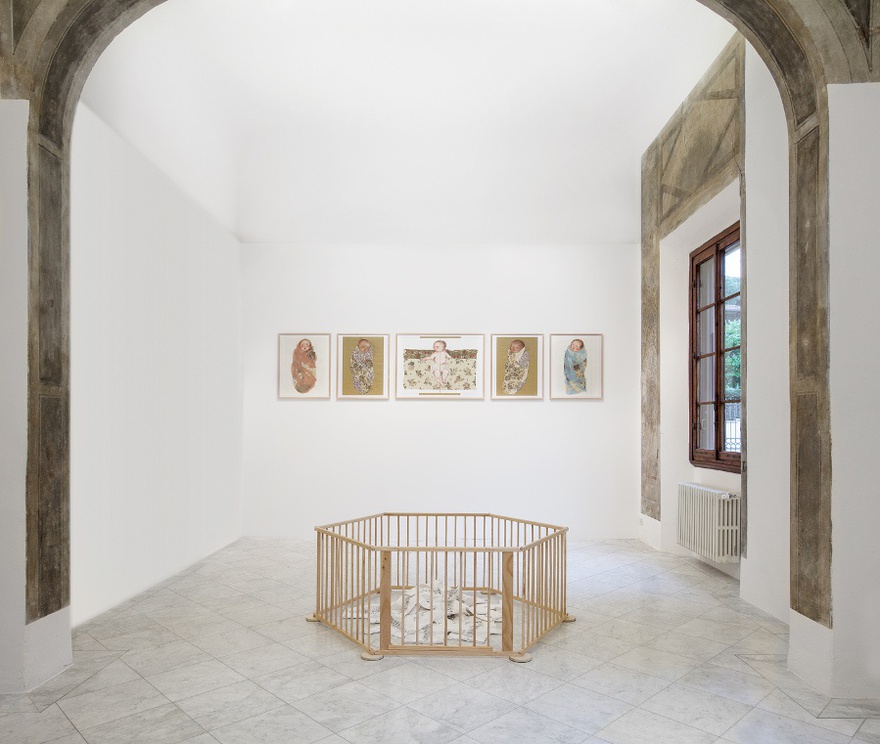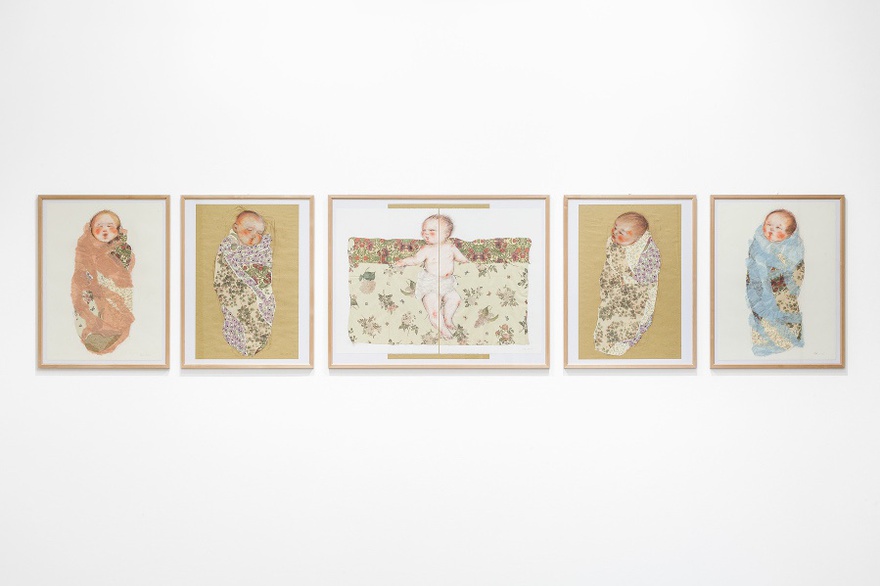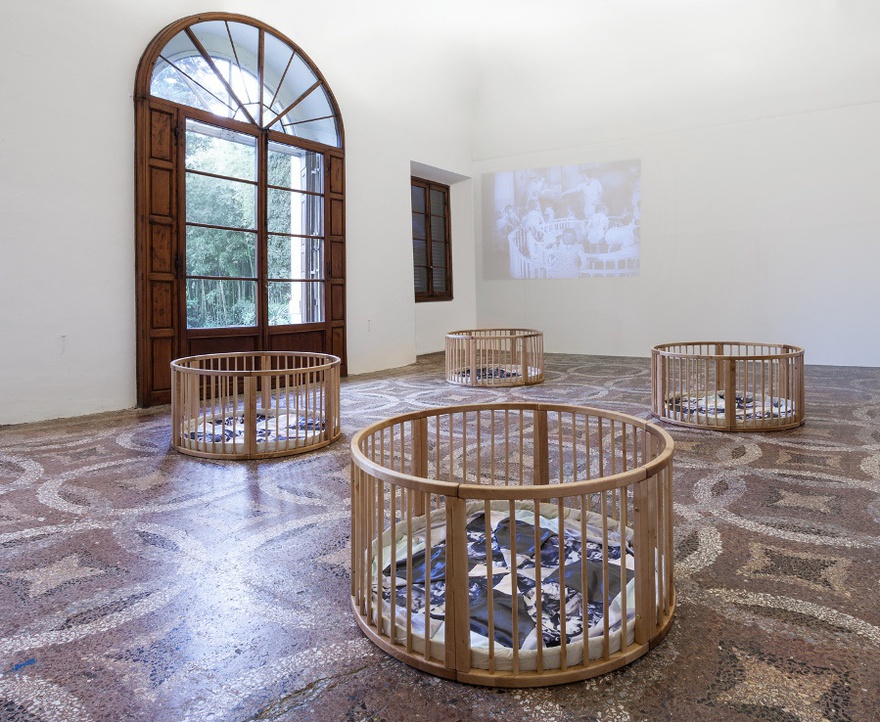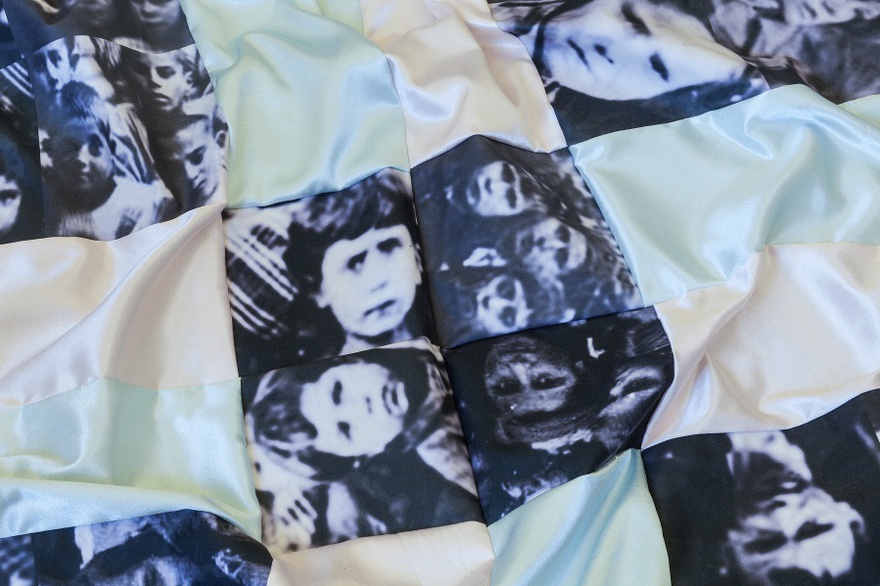Interviews
History All Wrapped Up
Gülsün Karamustafa in conversation with Basak Senova
In this conversation with Basak Senova, Gülsün Karamustafa discusses her recent solo exhibition Swaddling the Baby at Villa Romana, Florence. Karamustafa explains the genesis of her work, initially inspired by a trip to Florence in 1969 and a long-standing friendship and collaboration with director of Villa Romana, Angelika Stepken. Karamustafa explains how her work traces the migratory patterns of some of the most vulnerable ethnic identities in modern history through the familiar tradition of swaddling. The result is an exhibition that includes installation and video as well as Karamustafa's first drawing works in over a decade.
Basak Senova: The exhibition is the end result of your residency at Villa Romana, a German institution located in Florence, Italy. You have a long record of collaboration and friendship with Angelika Stepken, who is the director of the institution. Could you talk about this dialogue that formed the basis for your residency and the exhibition?
Gülsün Karamustafa: I first met Angelika Stepken in Berlin in 1998 during the opening of the show İskorpit that took place in Haus der Kulturen der Welt. She was then the director of Badischer Kunstverein in Karlsruhe and the İskorpit exhibition was moving to her institution in 1999. The other thing that connected us was that she had written the catalogue text for my work Bühne (1998), which was being shown in Germany for the first time. It was a brief paragraph but when I first read it I was extremely touched as it described the work in such a way that perhaps even I would not have been able to express. I remember reusing this text, with her permission, in several other catalogues concerning this work.
In the contemporary art world there is so much movement that it is sometimes not possible to work with the same curator, even though you hope that your paths will cross. So I was lucky that Angelika created this opportunity to collaborate again after our first meeting 17 years ago. For me this invitation from Villa Romana has been a very enjoyable and creative encounter.
BS: The exhibition is closely connected to the city of Florence. Could you explain the starting point for the exhibition?
GK: The first time I visited Florence, in 1969, I was still an art student. Like many others, I was most fascinated by Brunelleschi's 'Ospedale degli Innocenti' (Hospital of the Innocents), which was a building for orphans. I stood stunned in the middle of the square in front of the reliefs of the swaddled babies created by the famous sculptor Andrea Della Robbia. The dramatic stories that took place behind those walls impressed me more than anything. Even as early as the fifteenth century, this orphanage was built to take care of the orphans and illegitimate children within society, running on donations from the rich silk merchants of Florence.
At that moment I started to think about how I could include this theme in my artwork but at that time I had no idea how to interpret it. Therefore, the chance to spend some more time in Florence brought me back to this idea again. I dedicate my work to the memory of those children as well as those who survived in orphanages in times of wars, genocides and migrations.
BS: What is your approach to processing such personal narratives? Do you perceive your work as an articulation of these narratives or just an interpretation of them?
GK: Actually, I follow none of those approaches while I am creating a work. It is the background story that attracts me and gives me the urge to follow this path. The imagery of the work is knitted in my mind day by day with the details that I search for or that come my way by chance – the photographs, the looks, the gestures in some of those images; the footage that I collect from here and there; the objects that I put aside thinking that they might be useful. Sometimes it becomes such a huge pile that I lose myself in the images and come to a point of drowning. Afterwards comes the time to be selective – that is probably the most crucial moment. I never try to articulate or interpret anything at this step. I get a feeling of flux from this activity of tracing a story and I always try to include this in my work. After leaving behind the surplus I stay with 'what remains'.
BS: How do you complete the missing links and unknown details within these narrations?
GK: As I am not so concerned with the literary interpretation of the stories I follow, I do not feel the need to add such details to the facts and figures. But I am often inspired to follow certain clues – a rumour, a simple image, or a detail from everyday life – and maybe this loose way of following a story gives me the opportunity to catch its real spirit in my works.
BS: You have produced most of the works for the exhibition during your three-week residency in Florence but you have also combined the new pieces with some older works. Could you talk about the process of developing the exhibition?
GK: After receiving the invitation from Villa Romana, I started to work on this theme of orphans and swaddling immediately. I went through thousands of photographs of orphanages on the Internet and I was confronted with the faces of Armenian, Greek, Jewish, British, Crimean, Korean and Japanese children. The most captivating part was their eyes – the looks of those children in despair and fear. This initiated the first part of my project, where I created patchwork blankets featuring the faces of orphans. I also wanted to put together some old footage to make a short film to accompany the exhibition, which I produced in Istanbul.
In most of the photographs depicting the inside of the orphanages, the children were taken care of in groups and were put in the same playpens. So, for me, the decision to include some real playpens in my project was inevitable and I placed the patchwork blankets of the orphan's faces inside them. We ordered the playpens from the Internet to be delivered to the Villa but the core of the project was completed in Florence so that I could experience the theme again in its original space. I had no idea what was to come then. The drawings of the babies swaddled in the special 'Florence Wrapping Papers' are the product of the city itself.
I also included an older work of mine in this project, Create Your Own Story With the Given Material (1997), which consists of 30 completely sewn up infant's body suits, as it is another work that connects me to Angelika Stepken. It was one of the works that we showed in Kunstwerein in 1999.
BS: Speaking of the drawings, they share a lot of commonalities with your earlier works from the 70s and 80s. Could you talk about this act of revisiting your own archive – not only in terms of content, but also in terms of technique and medium?
GK: On my arrival in Florence, with the idea of making drawings in my mind for this specific project, I realised that I had not made any paintings or drawings since 2004. In the last 11 years, I have always worked on large installations or videos relating to the exhibitions that I was invited to. At first I felt anxious about what would happen and if my hand would still work as before. This feeling dissolved when I found this incredibly beautiful shop, run by a small family in a discreet part of Florence, which sold art materials. They provided me with what I needed in a most gentle way. When I touched the drawing charcoal and the soft pastel set I immediately felt that drawing and painting is a gift that you carry until the moment of death.
The other materials of the city that I found very enchanting, as I previously mentioned, were the 'wrapping papers' that were sold in nearly every tourist shop and were covered with traditional patterns. They were extremely rich in colour and design and were inevitably a great influence on my idea to use baby swaddling or wraps in my work. I was interested in the idea of these materials as a way to keep babies away from the everyday dangers of life. Those tender words like swaddling, cuddling and wrapping fitted so well with what I was doing and I decided to wrap and swaddle my babies in those special Florence wrapping papers.
BS: In terms of thinking about the different ethnic identities in such a context, how do you relate your work to the diverse realities in Turkey?
GK: When I searched the Internet for the word 'orphanage' the first group of images I was confronted with were the extremely sad and touching faces of the Armenian children after 1915, followed by the groups of Greek children who were taken into care throughout the Balkan Wars. Then there were the Jewish children who managed to survive the Second World War and the Kurdish children. If you follow the trajectory of the children who managed to survive through times of disaster, you have a very solid map of recent history. Of course, those images also create a map of ethnic identities whose ultimate fate can be linked to Turkey and for which we should all feel responsible.
BS: The title of the exhibition Swaddling the Baby can be read in different ways, could you elaborate on it?
GK: The name has a direct reference to Andrea della Robbia's swaddled baby reliefs that feature on Brunelleschi's building, which are wrapped in white cloth and tied with blue ribbons. The babies and the group of collages and drawings came to life in that very short time in Florence. Whilst I stayed and worked in Villa Romana I read so much about the tradition of swaddling and found out that it is experienced in very many cultures in many different ways. A child, and especially an orphan, needs to be wrapped softly in order to be, and feel, protected from the dangers of the world.
Swaddling the Baby was on show at Villa Romana, Florence, from 29 April–12 June 2015.
Gülsün Karamustafa (Ankara, 1946) graduated from State Academy of Fine Arts in Istanbul. She lives and works in Istanbul. Her solo exhibitions include Swaddling the Baby, Villa Romana, Florence (2015); An Ordinary Love, Rampa, Istanbul (2014); A Promised Exhibition, SALT Ulus, Ankara (2014), SALT Beyoğlu, SALT Galata, Istanbul (2013); Mobile Stages, Salzburger Kunstverein, Salzburg (2008); and Bosphorus 1954, Kunstmuseum Bonn, Bonn (2008), among others. She has taken part in many group exhibitions including the 31st Sao Paulo Biennial (2014); the 3rd and 10th Gwangju Biennials (2000, 2014); Art Histories, Museum der Moderne Salzburg (2014); Artevida Politica, Museu de Arte Moderna do Rio de Janeiro (2014); the 4th Thessaloniki Biennale (2013); the 1st Kiev Biennale (2012); and the Singapore Biennial (2011). Karamustafa received the Prince Claus Award in 2014.



















